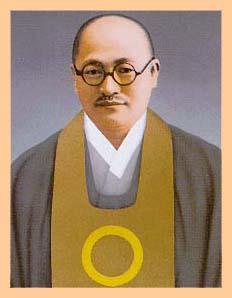 Won is a modern school of Buddhism, established in Korea in 1916. Won’s founder, Sotaesan, adapted traditional Buddhist teachings to apply them to the modern world. The name “Won Buddhism” comes from the Korean words won (“circle”) and bulgyo (“Buddhism”), literally meaning “Round Buddhism” or “Consummate Buddhism.” By “consummate,” Won Buddhists mean that they incorporate several different schools of Buddhist thought into their practice.
Won is a modern school of Buddhism, established in Korea in 1916. Won’s founder, Sotaesan, adapted traditional Buddhist teachings to apply them to the modern world. The name “Won Buddhism” comes from the Korean words won (“circle”) and bulgyo (“Buddhism”), literally meaning “Round Buddhism” or “Consummate Buddhism.” By “consummate,” Won Buddhists mean that they incorporate several different schools of Buddhist thought into their practice.
Introduction
Won Buddhism is a modern Buddhist folk movement in South Korea, founded by Sotaesan (1891-1943). The practice of Won Buddhism has two aspects: realisation of buddha-nature and “time-less and placeless Zen.” This means that the adherents of Won Buddhism seek to see the Buddha in all things and to live in accordance with this insight. This type of meditation is called timeless and placeless because it does not depend on specific meditation periods and balls, but is to be practised always and everywhere.
In Won Buddhism only one meditation object is used – a black circle on a white field, which symbolises the cosmic body of Buddha, the dharmakaya. The name of the school is derived from this circle. Won Buddhism is not a purely monastic religion. Monks are permitted to marry. There are no specific ceremonies and rituals; an attempt is made to adapt to the needs of modern men and women. Thus the most important sutras were translated into easily understandable Korean.
The followers of Won Buddhism are active in social and charitable work. In the post-war years they established numerous kindergartens, schools, and universities. Sotaesan spent many of his youthful years in ascetic practice, until in 1915 he attained “great enlightenment.” Nine disciples attached themselves to him to practice and study the Buddhist teachings. In 1924 he founded the Association for the Study of the Buddha-Dharma, which, however, remained quite limited in its effect during Japanese colonial rule. Only in 1946 were his teachings propagated, under the name Won Buddhism, throughout South Korea. Today Won Buddhism has many followers.
Founder – Sotaesan
Sotaesan, the Founder of Won Buddhism – Sot’aesan is his Dharma name, and Taejongsa is his Dharma Title, by which he is referred to within the Won Buddhist order. Sot’aesan Taejongsa was born as a son of a peasant on May 5, 1891 in Youngchon, Kilryong Li, Paeksoo Myeon, Youngwang County, Chunnam Province. Sotaesan’s path to Buddhist awakening started with common questions. Since the age of seven, Sotaesan had inquired into the natural phenomena of the universe; the processes of human life – birth, aging, diseases, and death; various human emotions – happiness, anger, sadness, and joy.
After twenty years of incessant searching he finally obtained the great awakening after entering nirvana. After the great awakening, Sot’aesan observed that people of the contemporary world were enslaved by materialism due to the loss of spiritual power, which can make good use of materials. He founded the Won Buddhist order with the goal of leading all human beings from the state of samsara into paradise on earth with the help of his nine disciples.
He initiated many innovations – such as dispensing with formalities and vanity, abolishing superstition, executing thrift and savings, and erecting an embankment to reclaim land from the sea. Sotaesan wrote the doctrine and institutional system of Won Buddhism. He established the headquarters of Won Buddhism in Iksan city and started the Won Buddhist community in the headquarters. He passed away at the age of 53 on June 1, 1943, after twenty eight years’ selfless mission.
Brief History of Won Buddhism
Many people came to Sotaesan who was awakened to the Truth of Irwon (Dharmakaya). From among them, Sotaesan chose nine disciples for the foundation of the Won Buddhist order. He established a successful embankment project which reclaimed a beach for use as farm-land. While contemplating the Truth of Irwon with his nine disciples, at the mountain peaks for 100 days, he received authentication for the mission of the Won Buddhist order from the realm of Buddha. Sotaesan established the headquarters of the new order in Sinyong Dong, Iksan City,(Formerly Iri), the present headquarters.
Sotaesan wrote and edited Chong-jon – the basic scripture – and other canonical texts.
Sotaesan was succeeded by Chongsan, Kyu Song (1900-1962), who was born in Songju, Korea, Kyongbuk Province. Chongsan performed relief work for war refugees after Korea won its independence from Japanese control and after the civil war between North and South Korea. He passed away on January 22, 1962 after twenty-nine years’ mission. Chongsan was succeeded by Taesan, Taego Kim (1916-), the Third Prime Master. Taesan actively promotes plans for building one global community.
Some Teachings

WON is neither Zen, nor Pure Land, but a combination of both. In the Chonjon Sot’aesan says we chant NAMO AMITA BUL toward the Amida Buddha for salvation.
However, meditation is also a key to practice. There is no Buddha image at the temple, “0” is representative of the WON Buddhist order. The great master advises, find your sutra and follow it.
True Buddhism will become one of the major religions practised in the world. In the future, however, Buddhism should not be the same system as that of the old Buddhism, but should be practised by scholars and officials, farmers, artisans and merchants. It should be a Buddhism not only for monks, but for all laity. As for the way of worshipping the Buddha, we should not regard a Buddha image as a real Buddha, but we should know that all things in the universe are Buddhas and everything we are doing is the practice of Buddha Dharma. When we do ordinary things faithfully, we are practising Buddha Dharma faithfully. The one who studies Buddha Dharma successfully can accomplish worldly affairs as well. As to the way of offering worship to Buddha, there is no particular Dharma Hall or Buddha image for offering worship to the Buddha. Every place is to be our Dharma Hall and everything is to be our Buddha image for offering worship to the Buddha. Then, we will be living in Dharma Halls and surrounded by Buddhas, and, at the same time, the benefactions of Buddha will spread over the whole universe, making this world an unimaginably blessed Buddhist paradise.
Mission of Won Buddhism
In addition to its headquarters in Iksan city, Korea, There are 20 dioceses and about 400 temples nationwide in Korea. Won Buddhist mission reaches several foreign countries, including the United States of America. There are about thirty Won Buddhist temples around the world, which actively carry out the missions. There are facilities for educational, training, charitable, medicinal, academic, industrial, and other projects.
Goals of Won Buddhist Mission: The Won Buddhist order is bringing beneficence to the human race by way of mission, education, and charity, which are its three major tasks. Mission is accomplished mainly at the Won Buddhist temples. It goal to deliver Won Buddhist teachings to people who have are seeking a more enlightened way. It also purposes to help people to discover the Buddha nature within themselves – which is equal to the nirvana of Buddhas – and to become free from karmic bondage augmented by regular services, training sessions, rituals, counselling, and other support in the temples.
Sotaesan reflected upon the nature of the material world in this day and age:
“At present, materialism has an increasing influence in the world today, while the minds of human beings are becoming weak. In these circumstances, individuals, homes, societies and nations are not able to maintain equilibrium and must remain in endless suffering. Can we who have made up our minds to help other people neglect this situation? We know of saints and sages who, with utmost sincerity, gave prayers for all living beings and received a response from Heaven. Now I suggest that this is the time for us to pray incessantly to Heaven and Earth until Heaven and Earth respond to our prayers. Then people can be the masters of material things, instead of being tempted by them. Your mind is equivalent to the mind of Heaven; your virtue will meet with the virtue of Heaven and Earth when the last bit of self-centered desire has left your mind. Everything will then turn out successfully, as you desired. You should be conscious of the fact that you possess the ability to impress the will of Heaven and at the same time should always be aware of your own responsibility to save all sentient beings.”
Won Buddhist educational task seeks to dispel the negative effects of karma and realises ignorance, and to manifest brightness and the emancipation that comes with knowledge. These goals are fulfilled in the educational institutions affiliated with the Won Buddhist order.
At the same time, Won Buddhism’s goal for education is the goal of education in general, which purposes to promote human spirituality and world civilization for a better world. Charitable work aims to protect disadvantaged people in the realms of spiritual, physical, or material conditions, and to help them to cultivate independence. It also aims to build a society based on the ideals of perfection and equality. For these goals, the Won Buddhist order has established many charitable institutions and welfare facilities for homeless people, orphans, disabled people, aged people, sick people, and various neglected people in the society.
Proposals for World Peace

Won Buddhism nor Buddhism in general, is not confined to one nation or one race. Won Buddhism goals extend beyond boundaries. Sotaesan advocated lrwonism himself, and claimed that all religions meet at the thought of lrwonism because the final goal of religions is one and the same. Sotaesan taught Samdong Morality (The Morality based on the Three Principles of Identity). The First Principle of Identity, “All Doctrines Have the Same Origin,” suggests that each religion should expand beyond its own boundaries to open up to other religions, since all religions share one Truth and the same goal.
The Second Principle of Identity, “All Living Beings Are Related by the Same Force (of Life),” suggests that the human race ought to live as brothers, free from fighting or resentment, since all human beings are of one family.
The Third Principle of Identity, “All Enterprises Are for the Same Purpose’, suggests that all human enterprises and assertions need to cooperate with each other, rather than rejecting one another, in order to construct a better world on earth. Chongsan’s spirit of Samdong Morality is succeeded by Taesan’s proposals for world peace, namely, cultivation of the mind-field, development of a worldwide market and the united religions movement “Cultivation of the Mind-field” purposes to foster the strength of mind, which can then make good use of scientific and technological advancement.
Sotaesan taught that human beings become enslaved to materialism and degenerate due to the influence of advanced science and technology. The United Religions Movement” purposes to free the individual from one’s own religious egotism and boundaries, and to fulfil the original mission of religion. In furtherance of the goal of religious cooperation, the Won Buddhist community proposes to establish an institutionalised organisation for world religions comparable to, and on parallel with, the United Nations organisation. The Won Buddhist community aims to take the lead in removing the boundaries and barriers of the past, and creating one global family on earth, in tandem with other religious communities.

Won Buddhist Temple Meditation Room, Chapel Hill, North Carolina
![]()

